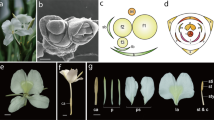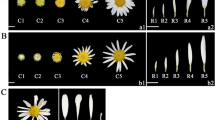Abstract
Understanding of the molecular interplay, which determines early steps of flower formation has grown considerably during last years. In contrast, genetic actions responsible for how flower organs acquire their size and shape at later phases of organogenesis are still poorly understood. We have exploited the large and anatomically simple Gerbera (Gerbera hybrida var. Terra regina) ray flower petals to describe transcriptional changes during organogenesis. Gerbera 9 K cDNA microarray was utilized to profile gene expression at six different developmental stages of petal organogenesis, at the earliest stage expansion of petals is starting and at the latest stage petals have reached their final size and shape. Genes potentially participating in petal opening were identified based on the similarity in expression with a known marker gene. Our results showed characteristic sets of genes expressed during the cell division and cell expansion phases of petal development. Interestingly, there was a transition stage during which neither cell division nor cell expansion marker genes were abundantly expressed. Moreover, constitutive expression of late petal specific genes indicates that they participate in petal organogenesis throughout the development and they are not involved in stage specific switch points.



Similar content being viewed by others
Abbreviations
- AGI:
-
Arabidopsis genome initiative
- BLAST:
-
Basic local alignment search tool
- EST:
-
Expressed sequence tag
- FDR:
-
False discovery rate
- IAA:
-
Indole-3-acetic acid
- MIAME:
-
Minimum information about a microarray experiment
- RT-RT-PCR:
-
Real time reverse transcriptase polymerase chain reaction
References
Bey M, Stüber K, Fellenberg K, Schwarz-Sommer Z, Sommer H, Saedler H, Zachgo S (2004) Characterization of Antirrhinum petal development and identification of target genes of the class B MADS box gene DEFICIENS. Plant Cell 16:3197–3215
Breeze E, Wagstaff C, Harrison E, Bramke I, Rogers H, Stead A, Thomas B, Buchanan-Wollaston V (2004) Gene expression patterns to define stages of post-harvest senescence in Alstroemeria petals. Plant Biotechnol J 2:155–168
Breviario D, Nick P (2000) Plant tubulins: a melting point for basic questions and promising applications. Transgenic Res 9:383–393
Breyne P, Dreesen R, Vandepoele K, De Veylder L, Van Breusegem F, Callewaert L, Rombauts S, Raes J, Cannoot B, Engler G, Inze D, Zabeau M (2002) Transcriptome analysis during cell division in plants. Proc Natl Acad Sci USA 12:14825–14830
Cameron KD, Teece MA, Smart LB (2006) Increased accumulation of cuticular wax and expression of lipid transfer protein in response to periodic drying events in leaves of tree tobacco. Plant Physiol 140:176–183
Channeliere S, Riviere S, Scalliet G, Szecsi J, Jullien F, Dolle C, Vergne P, Dumas C, Bendahmane M, Hugueney P, Cock JM (2002) Analysis of gene expression in rose petals using expressed sequence tags. FEBS Lett 515:35–38
Coen ES, Meyerowitz EM (1991) The war of the whorls: genetic interactions controlling flower development. Nature 353:31–37
Chang C, Stadler R (2001) Ethylene hormone receptor action in Arabidopsis. Bioessays 23:619–627
Dafny-Yelin M, Guterman I, Menda N, Ovadis M, Shalit M, Pichersky E, Zamir D, Lewinsohn E, Adam Z, Weiss D, Vainstein A (2005) Flower proteome: changes in protein spectrum during the advanced stages of rose petal development. Planta 222:37–46
Dong CH, Xia GX, Hong Y, Ramachandran S, Kost B, Chua NH (2001) ADF proteins are involved in the control of flowering and regulate F-actin organization, cell expansion, and organ growth in Arabidopsis. Plant Cell 13:1333–1346
Grudkowska M, Zagdánska B (2004) Multifunctional role of plant cysteine proteinases. Acta Biochim Pol 51:609–624
Guterman I, Shalit M, Menda N, Piestun D, Dafny-Yelin M, Shalev G, Bar E, Davydov O, Ovadis M, Emanuel M, Wang J, Adam Z, Pichersky E, Lewinsohn E, Zamir D, Vainstein A, Weiss D (2002) Rose scent: genomics approach to discovering novel floral fragrance-related genes. Plant Cell 14:2325–2338
Helariutta Y, Elomaa P, Kotilainen M, Seppanen P, Teeri TH (1993) Cloning of cDNA coding for dihydroflavonol-4-reductase (DFR) and characterization of dfr expression in the corollas of Gerbera hybrida var. Regina (Compositae). Plant Mol Biol 22:183–193
Hwang YS, Bethke PC, Cheong YH, Chang HS, Zhu T, Jones RL (2005) A gibberellin-regulated calcineurin B in rice localizes to the tonoplast and is implicated in vacuole function. Plant Physiol 138:1347–1358
Kirch HH, Vera-Estrella R, Golldack D, Quigley F, Michalowski CB, Barkla BJ, Bohnert HJ (2000) Expression of water channel proteins in Mesembryanthemum crystallinum. Plant Physiol 123:111–124
Inoue T, Higuchi M, Hashimoto Y, Seki M, Kobayashi M, Kato T, Tabata S, Shinozaki K, Kakimoto T (2001) Identification of CRE1 as a cytokinin receptor from Arabidopsis. Nature 22:1060–1063
Kotilainen M, Helariutta Y, Mehto M, Pöllänen E, Albert VA, Elomaa P, Teeri TH (1999) GEG participates in the regulation of cell and organ shape during corolla and carpel development in Gerbera hybrida. Plant Cell 11:1093–1104
Laitinen RA, Immanen J, Auvinen P, Rudd S, Alatalo E, Paulin L, Ainasoja M, Kotilainen M, Koskela S, Teeri TH , Elomaa P (2005) Analysis of the floral transcriptome uncovers new regulators or organ determination and gene families related to flower organ differentiation in Gerbera hybrida (Asteraceae). Genome Res 15:475–486
Lloyd C, Chan J (2004) Microtubules and the shape of plants to come. Nat Rev 5:13–22
Maldonado AM, Doerner P, Dixon RA, Lamb CJ, Cameron RK (2002) A putative lipid transfer protein involved in systemic resistance signalling in Arabidopsis. Nature 419:399–403
Martin C, Gerats T (1993) Control of pigment biosynthesis genes during petal development. Plant Cell 5:1253–1264
Nieuwland J, Feron R, Huisman BA, Fasolino A, Hilbers CW, Derksen J, Mariani C (2005) Lipid transfer proteins enhance cell wall extension in tobacco. Plant Cell 17:2009–2019
Osato Y, Yokoyama R, Nishitani K (2006) A principal role for AtXTH18 in Arabidopsis thaliana root growth: a functional analysis using RNAi plants. J Plant Res 119:153–162
Papadopoulou K, Melton RE, Leggett M, Daniels MJ, Osbourn AE (1999) Compromised disease resistance in saponin-deficient plants. Proc Natl Acad Sci USA 96:12923–12928
Pontier D, Gan SS, Amasino RM, Roby D, Lam E (1999) Markers for hypersensitive response and senescence show distinct patterns of expression. Plant Mol Biol 39:1243–1255
Pruitt RE, Vielle-Calzada JP, Ploense SE, Grossniklaus U, Lolle SJ (2000) FIDDLEHEAD, a gene required to suppress epidermal cell interactions in Arabidopsis, encodes a putative lipid biosynthetic enzyme. Proc Natl Acad Sci USA 97:1311–1316
Razem FA, El-Kereamy A, Abrams SR, Hill RD (2006) The RNA-binding protein FCA is an abscisic acid receptor. Nature 439:290–294
Reale L, Porceddu A, Lanfaloni L, Moretti C, Zenoni S, Pezzotti M, Romano B, Ferranti F (2002) Patterns of cell division and expansion in developing petals of Petunia hybrida. Sex Plant Reprod 15:123–132
Reinhardt D, Pesce ER, Stieger P, Mandel T, Baltensperger K, Bennett M, Traas J, Friml J, Kuhlemeier C (2003) Regulation of phyllotaxis by polar auxin transport. Nature 426:255–260
Rolland-Lagan A-G, Bangham JA, Coen E (2003) Growth dynamics underlying petal shape and asymmetry. Nature 422:161–163
Rolland-Lagan AG, Coen E, Impey SJ, Bangham JA (2005) A computational method for inferring growth parameters and shape changes during development based on clonal analysis. J Theor Biol 232:157–177
Romano P, Gray J, Horton P, Luan S (2005) Plant immunophilins: functional versatility beyond protein maturation. New Phytol 166:753–769
Shevchik VE, Hugouvieux-Cotte-Pattat N (2003) PaeX, a second pectin acetylesterase of Erwinia chrysanthemi 3937. J Bacteriol 185:3091–3100
Singh S, Cornilescu CC, Tyler RC, Cornilescu G, Tonelli M, Lee MS, Markley JL (2005) Solution structure of a late embryogenesis abundant protein (LEA14) from Arabidopsis thaliana, a cellular stress-related protein. Protein Sci 14:2601–2609
Teeri TH, Elomaa P, Kotilainen M, Albert VA (2006) Mining plant diversity: Gerbera as a model system for plant developmental and biosynthetic research. Bioessays 28:756–767
Ueguchi-Tanaka M, Ashikari M, Nakajima M, Itoh H, Katoh E, Kobayashi M, Chow TY, Hsing YI, Kitano H, Yamaguchi I, Matsuoka M (2005) GIBBERELLIN INSENSITIVE DWARF1 encodes a soluble receptor for gibberellin. Nature 437:693–698
Vassileva VN, Fujii Y, Ridge RW (2005) Microtubule dynamics in plants. Plant Biotechnol 22:171–178
Vercauteren I, de Almeida Engler J, De Groodt R, Gheysen G (2002) An Arabidopsis thaliana pectin acetylesterase gene is upregulated in nematode feeding sites induced by root-knot and cyst nematodes. Mol Plant Microbe Interact 15:404–407
Wirdnam C, Motoyama A, Arn-Bouldoires E, van Eeden S, Iglesias A, Meins F Jr (2004) Altered expression of an ankyrin-repeat protein results in leaf abnormalities, necrotic lesions, and the elaboration of a systemic signal. Plant Mol Biol 56:717–730
Woodward AW, Bartel B (2005) Auxin: Regulation, action, and interaction. Ann Bot 95:707–735
Yu D, Kotilainen M, Pöllänen E, Mehto M, Elomaa P, Helariutta Y, Albert VA, Teeri TH (1999) Organ identity genes and modified patterns of flower development in Gerbera hybrida (Asteraceae). Plant J 17:51–62
Zenoni S, Reale L, Tornielli GB, Lanfaloni L, Porceddu A, Ferrarini A, Moretti C, Zamboni A, Speghini A, Ferranti F, Pezzotti M (2004) Downregulation of the Petunia hybrida α-expansin gene PhEXP1 reduces the amount of crystalline cellulose in cell walls and leads to phenotypic changes in petal limbs. Plant Cell 16:295–308
Zik M, Irish VF (2003) Global identification of target genes regulated by APETALA3 and PISTILLATA floral homeotic gene action. Plant Cell 15:207–222
Acknowledgments
Dr. Petri Auvinen from the Microarray Unit of the Institute of Biotechnology, University of Helsinki, is thanked for providing facilities and guidance during this work. Dr. Outi Monni from the Biomedicum Biochip Centre, University of Helsinki, is thanked for printing the microarray slides. We thank Anu Rokkanen and Eija Takala for the technical help in the gerbera laboratory and Sanna Peltola for taking care of the plants in the greenhouse. We also thank Jarno Tuimala at the Finnish IT centre for science (CSC) for providing useful comments on the statistical analysis of microarray experiments. This work was supported by the Academy of Finland (grant no. 105981 for M.K., and no. 104608 for P.E.; Finnish Center of Excellence Programme 2000–2005, 2006–2011 for T.H.T.). R.L. is funded by the Viikki Graduate School in Biosciences, University of Helsinki.
Author information
Authors and Affiliations
Corresponding author
Additional information
Accession numbers: Microarray raw data and experimental design has been submitted to Array-Express, http://www.ebi.ac.uk/arrayexpress. The array design is under accession number A-MEXP-244 and A-MEXP-249 and the experimental data under accession E-MEXP-578. Microarray results from Laitinen et al. (2005) are under accessions E-MEXP-206 and E-MEXP-207. EST sequence data from this article can be found in the EMBL/GenBank data libraries under accession numbers AJ750001-AJ766994. EST sequence data and annotations are available in OpenSputnik database at http://www.sputnik.btk.fi and at Plant Genome network at http://www.pgn.cornell.edu.
Electronic supplementary material
Rights and permissions
About this article
Cite this article
Laitinen, R.A.E., Pöllänen, E., Teeri, T.H. et al. Transcriptional analysis of petal organogenesis in Gerbera hybrida . Planta 226, 347–360 (2007). https://doi.org/10.1007/s00425-007-0486-2
Received:
Accepted:
Published:
Issue Date:
DOI: https://doi.org/10.1007/s00425-007-0486-2




